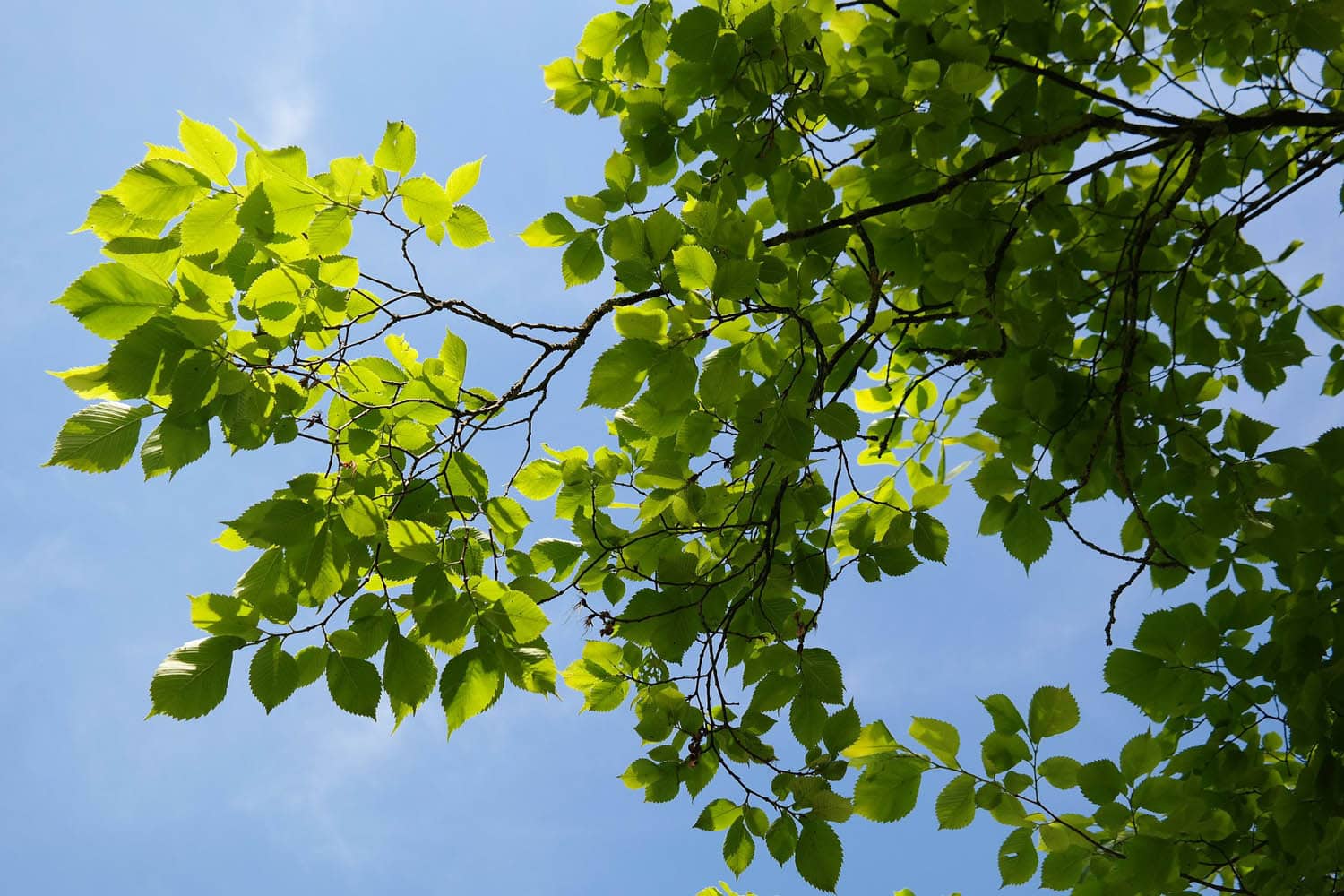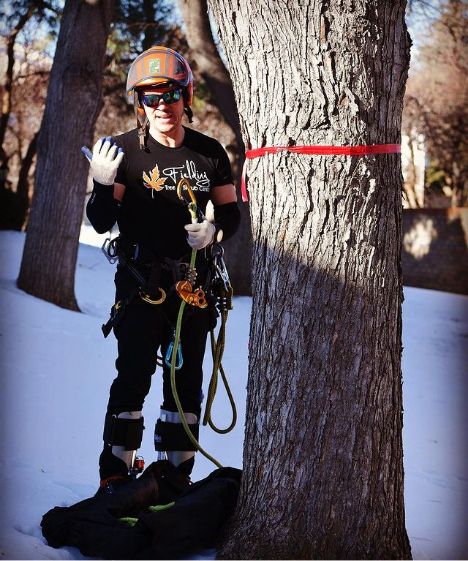Elm trees are towering beauties that bring much-needed shade to the Denver Front Range. Unfortunately, this species faces threats from several pests and diseases. Many homeowners turn to professional tree service providers in Denver for help recognizing elm trees on their property and keeping them safe and healthy. We hope these elm tree care tips help you understand how to protect and maintain these stunning trees.
Commonly Found Elm Species
There are different species of elm trees all over the globe and it’s important to know them in order to perform the best elm tree care. Here is a list of the popular varieties that thrive on the Front Range:
American Elm
This large deciduous tree will grow to approximately 75 ft tall and 70 ft wide when mature, providing plenty of shade under its beautifully shaped canopy.
Its ability to grow quickly, in many types of soil, makes it highly desirable in zones 2-9. The American elm is well suited to Denver because it can handle urban conditions and is resistant to drought. This produces 6 inch textured green leaves which turn vibrant yellow in the fall.
Camperdown Elm
Also called the Weeping elm, this large accent tree is a stand out with its graceful, draping limbs and sweeping low canopy. The Camperdown elm produces rich colored dark green leaves and grows best in Denver’s zone 5.
This elm species is known to be low maintenance and just needs full sun and room to spread! At maturity, it stands about 20 feet tall and 30 feet wide. This species is doing well in Denver due to its tolerance for high soil pH levels, urban conditions, environmental salt, and pollution.
Cherry-Bark Elm
Known for its longevity, this elm species can live for over one hundred years! You should plant Cherry-bark elm in wide open spaces because in adulthood they tower at about 100 feet tall! This beautiful giant produces bright green leaves and flowers during April and May. It is tolerant of several soil types but prefers to grow in zone 5. Because it defends itself well against Dutch elm diseases, it is sought after.
Chinese Elm
Another elm species known for standing up to the Dutch elm disease is the Chinese Elm. Standing 40-50 ft tall, this variety shares the same shape as the American Elm. It also has the noticeable flaky trunk that adds interesting texture and color to any landscape. The Chinese elm is native to Native China, Japan, North Korea, and Vietnam, and grows well in the U.S. throughout zones 4-9.
David Elm
The David elm is one of the smaller elm varieties, reaching approximately 30 ft tall at maturity. This Asian elm species originated in China, Japan, Korea, Mongolia, and Siberia, and can thrive in the U.S. in zones 3-8. Evidently, the David elm has a reputation for being hardy and can thrive in Denver due to its reduced size, urban tolerance, and ability to survive Dutch elm disease.
Siberian Elm
As its name suggests, this elm species originates from Eastern Siberia and Asian regions such as Korea, Tibet, India, and Mongolia. In the U.S Siberian elms grow up to 70 feet tall in zones 3-9. This hardy variety can withstand all types of conditions and thrive just about anywhere. No green thumb? These persistent elms are tough to destroy! Unfortunately, these same characteristics that make this species so tough have also landed them on the noxious weed watch list in Colorado. They are considered an invasive species and should not be planted on your Colorado property.
Slippery Elm
Looking to add some trees that offer more than just ornamental benefits to your landscape? Slippery elm is most known for their healing properties. Specifically, it’s called ‘slippery’ because of the mucilage that is found in the inner bark.
This variety’s bark has properties that help treat ailments like sore throats, irritable bowels, and heartburn. Slippery elms need room to grow. Surprisingly, at full maturity, they can reach between 80-130 ft tall!
How To Identify Denver’s Elm Trees
Easily identify different elms in your neighborhood and community by looking for these key features:
Leaf
- All elm tree leaves have a symmetrical base and doubly serrate margin at the tips.
- Evidently, an elm tree’s leaf shape is oval, with a point tip.
- Look closely and you can feel that the leaves are thick, rough, and deeply textured.
- The large leaves are normally about 4-7 inches long.
Bark
- Bark is relatively smooth on young adolescent trees.
- Mature, older trees develop a textured, rough bark.
- Slippery elm trees are easy to spot by looking at their smooth inner bark.
- Bark is typically grayish brown with irregular ridges.
Wood
- Elm wood is sought for its high density.
- The elm tree’s textured grains create a unique pattern in the wood.
- Elm wood is resistant to splits and decay, perfect for carpentry.
Elm Tree Diseases
Several life-threatening diseases are common among Denver elm trees. In the long run, knowing the dangers elm trees face is the first step in elm tree care towards preventing them.
Dutch Elm Disease
Dutch elm disease, an aggressive fungal pathogen, spreads from tree to tree by the elm bark beetle and is the highest threat to American elm trees in the United States. The fungus blocks the tree’s water conducting and vascular system, therefore resulting in death within the year.
In particular, when Dutch elm disease is removed and disposed of, it will provide health and safety for all other trees nearby. If detected very early, it is possible to manage the disease by removing affected branches.
Bacterial Wetwood
Sadly, this common disease affects several shade tree species in Colorado. It attacks the tree’s inner core and creates bacterial slime toxic to the wood. Visible signs include yellow discolored wood, wet-looking bark and sometimes a slimy, foamy white ooze. Unwanted pests are attracted to this slime.
Cytospora Canker
Cytospora canker is a fungal disease occurring on parts of elm trees that are stressed. The canker-causing fungi cause girdling of the plant, killing the plant above the canker. The Siberian elm is susceptible to this disease.
Elm Tree Infestations
Denver elm trees are plagued by a variety of pests, however, you can protect your trees with proactive treatment. Colorado State University Extension offers these quick fact details on each pest:
Aphids
- Aphids are found on all types of plants. A few species can cause plant injury.
- Some aphid species can curl the new leaves of some types of plant.
- Feeding aphids excrete honeydew, a sticky fluid that can attract other unwanted pests.
Leaf miners
- Leafminers are insects that feed within a leaf, producing large blotches or meandering tunnels.
- Leafminer injuries are conspicuous. They have little, if any, effect on plant health.
- Applied insecticides become significantly more useful after leafminers lay eggs.
Leaf beetle
- Adult elm leaf beetles chew holes in elm leaves, feed on the leaf surface, and create a lacy looking skeleton pattern.
- Adult elm leaf beetles spend winters in and around buildings, consequently they become a common nuisance invaders found within your home during this period.
- Some insecticides move systemically within plants. Allowing application to the soil to control elm leaf beetles.
Bark Beetle
- Elm bark beetles measure 1/12 to 1/6-inch long and are covered in stiff, yellowish hairs.
- Beetles dig small holes into trees and lay eggs underneath the bark layer.
- Elm bark beetles spread Dutch elm disease.
- It is important to note, effective treatment involves killing the beetles before they bore into the bark in fall and when they first emerge in spring.
Elm Tree Care And Treatment Options
The best thing you can do for your trees is keep them healthy. We can’t control the pests or bad weather in the world, but we can make sure that our trees have the best chance at enduring these obstacles in their lifetime.
When your body has an infection you take an antibiotic. Similarly, sometimes your trees need chemical intervention. Chemical controls can effectively control pests like elm leaf beetles, elm bark beetles, and aphids. For Elms in particular, our arborists at Fielding Tree Care recommend yearly soil treatments.
Stressed and injured trees develop fungal and bacterial diseases. Healthy trees can fight off infection! Here are our recommendations on best seasonal practices for keeping elm trees in tip-top shape:
Watering:
Proper watering is an overlooked, but very important tree care practice. Some elm varieties are prone to fungi related diseases if their soil becomes too saturated with water, and other times the damage can occur if there isn’t enough water. We can provide expert consultation on how much water you should be giving your elms, and how often.
Fertilization:
For many elm species, even the ones commonly found in Denver, the high alkaline soil can lead to problems with chlorosis. The best way to neutralize this threat is with the correct fertilizer application. Balancing the soil and getting your trees the nutrients they crave will keep them strong and healthy.
Tree trimming:
Annual pruning and trimming help elm trees keep their beautiful shape and foliage. Trimming damaged or slightly infected branches can save the whole tree!
With these elm tree care tips, you’ll have a flourishing landscape with lots of shade to relax under in no time. Remember that you can always schedule a complimentary on-site disease diagnosis of your elm trees. One of our arbor experts will walk you through our four-step approach for treating elm trees and create a custom plan for the unique needs of your trees.






